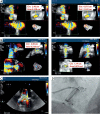Transcatheter paravalvular leak closure and hemolysis - a prospective registry
- PMID: 28507571
- PMCID: PMC5420624
- DOI: 10.5114/aoms.2016.60435
Transcatheter paravalvular leak closure and hemolysis - a prospective registry
Abstract
Introduction: Paravalvular leak (PVL) related to a surgical prosthetic valve may be associated with clinically significant hemolysis. The influence of transcatheter PVL closure (TPVLC) on hemolysis remains uncertain.
Material and methods: The prospective registry included patients undergoing TPVLC due to PVL-related heart failure and/or hemolysis. Procedural data, laboratory markers of hemolysis and heart failure status were recorded at baseline, discharge and at 1- and 6-month follow-up.
Results: Of 116 patients from all those qualified for TPVLC, 79 fulfilled the inclusion/exclusion criteria. Hemolysis was significantly more frequent in patients with mitral location of PVL and with calcifications in its channel. After TPVLC prompt reduction of lactate dehydrogenase activity (617.0 (342.0-899.0) vs. 397 (310.0-480.5) IU/l, p < 0.05) and gradual resolution of anemia (hemoglobin (HGB) 11.7 (10.4-13.8) vs. 13.4 (12.9-13.8) g%, p < 0.05) over 6 months were noted. Effective closure of PVL (> 90% reduction of PVL cross-sectional area) resulted in a more prominent increase of red blood cell count and HGB than in patients with residual regurgitation. The TPVLC-related exacerbation of hemolysis was recorded in 14 patients. Its risk was aggravated by presence of significant hemolysis at baseline or residual flow either by a partially uncovered channel or across the occluder. Reduction of hemolysis after successful TPVLC was sustained in 6-month follow-up.
Conclusions: Risk factors for PVL-related hemolysis were the presence of calcifications in the defect and mitral location of PVL. The TPVLC effectively reduced hemolysis if at least 90% reduction of PVL cross sectional area was achieved. The effect was sustained in 6-month follow-up. Incomplete closure of PVL may increase the magnitude of hemolysis after TPVLC, but it occurred rarely.
Keywords: hemolysis; occluder; paravalvular leak; percutaneous closure.
Conflict of interest statement
The authors declare no conflict of interest.
Figures




References
-
- Horstkotte D, Korfer R, Seipel L, Bircks W, Loogen F. Late complications in patients with Bjork-Shiley and St. Jude Medical heart valve replacement. Circulation. 1983;68:II175–84. - PubMed
-
- O’Rourke DJ, Palac RT, Malenka DJ, Marrin CA, Arbuckle BE, Plehn JF. Outcome of mild periprosthetic regurgitation detected by intraoperative transesophageal echocardiography. J Am Coll Cardiol. 2001;38:163–6. - PubMed
-
- Rallidis LS, Moyssakis IE, Ikonomidis I, Nihoyannopoulos P. Natural history of early aortic paraprosthetic regurgitation: a five-year follow-up. Am Heart J. 1999;138:351–7. - PubMed
-
- Davila-Roman VG, Waggoner AD, Kennard ED, et al. Prevalence and severity of paravalvular regurgitation in the Artificial Valve Endocarditis Reduction Trial (AVERT) echocardiography study. J Am Coll Cardiol. 2004;44:1467–72. - PubMed
-
- de Almeida Brandao CM, Pomerantzeff PM, Souza LR, et al. Multivariate analysis of risk factors for hospital mortality in valvular reoperations for prosthetic valve dysfunction. Eur J Cardiothorac Surg. 2002;22:922–6. - PubMed
LinkOut - more resources
Full Text Sources
Other Literature Sources
